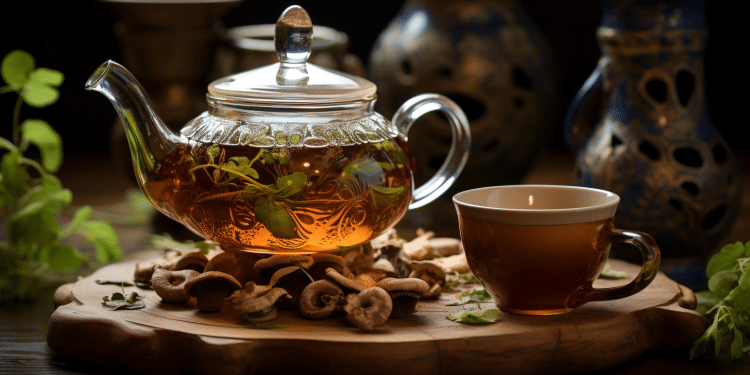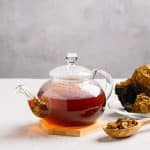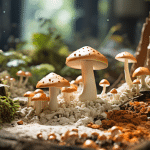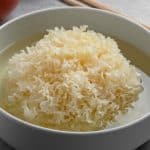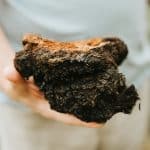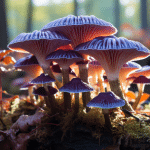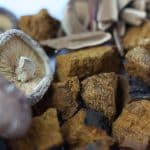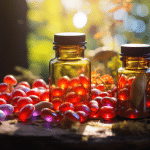Mushroom tea is one of the classic ways of reaping the benefits of medicinal mushrooms, including adaptogenic ones as well as ones that have nootropic effects. It is, of course, also a main way to utilize “magic mushrooms” (those with psilocybin) as well. Either way, making mushroom tea is incredibly simple, and you can blend it up as per your preferences.
Key Takeaways From this article:
Mushroom teas can be made with a wide variety of mushrooms, ranging from “magic” ones, to the more classic “healers” or medicinal mushrooms such as maitake, reishi, or lion’s mane. Mushroom tea is one of the best ways to get the healing benefits of mushrooms, if you are dealing with whole mushrooms. If you have the extract, you are much more flexible on how to prepare your tea or a myriad of other foods and drinks.
What is Mushroom Tea?
Mushroom Tea is just what you might expect, A liquid infusion made by steeping mushrooms in hot water. This releases therapeutic compounds, breaking down chitin, or the polymer layers that compose mushroom tissues, which are hard for the human body to digest. Making tea from your mushrooms helps to unlock its therapeutic potential by breaking beta-glucans and other beneficial compounds out of the chitin, making it more bioavailable for the body. Plus, it makes for a simple, fascinating consumption method, which you can jazz up with honey, lemon, cinnamon, or any other flavorings that appeal to you.
Mushroom tea provides more bioavailable forms of the following compounds from functional mushrooms:
Beta-Glucan
Beta-glucans are a type of polysaccharide which are far more bioactive than other carbohydrates. Because they are bioactive, they are usually associated with positive health effects from many mushrooms. Many sources consider that b-glucan is the main ingredient that is responsible for the overall benefits of any fungus formulation.
Terpenoids
Most medicinal mushrooms also contain a number of different terpenoids, which is a rearranged classification of terpenes. These are the lipids thought to provide the different mushrooms with their immune-modulating benefits.
Superfood Benefits
It is no secret that a lot of mushrooms are considered superfoods, meaning that they provide lots of nutrient benefits, including certain vitamins and minerals that are not abundant in our regular diets. Now that you know what healing compounds you can reap from medicinal mushrooms, it is time for your next question, which mushrooms offer what benefits.
What type of mushroom is best for mushroom tea?
Outside of common varieties found in the grocery store, portabello and crimini, for example, and, of course, the Psilocybin mushrooms, most people are not familiar with most mushroom varieties that are available. More worryingly, many people are unaware of the benefits functional mushrooms have to offer, or are unsure about what mushrooms to select for specific health benefits.
After all, once you start familiarizing yourself with more of the most popular medicinal mushrooms, lions mane, reishi, chaga, maitake, etc., it becomes harder to stay on top of things. If you are trying to decide what medicinal mushrooms to use for tea, you will be glad to hear that just about any mushroom will make for a good, nutritious cup of tea. Some mushrooms simply have specific, special health benefits.
- Lions Mane is a mild-tasting, sweet-tasting mushroom associated with increased mental productivity and improved function in other areas of the brain.
- Maitake is an earthy, herbaceous-tasting mushroom known for its adaptogenic effects, which can positively affect digestive, cholesterol, and immune functions.
- Cordyceps is known as “the athletes mushroom” because it has a potential to improve endurance, athletic performance, and heart health.
- Tremella is known as the “beauty mushroom” due to its hydrating properties and proposed anti-aging effects on skin.
- Reishi is a relaxing, sleep-supporting mushroom that has adaptogenic properties.
- Chaga is another soothing mushroom that has some potential for immune boosts and helps to regulate inflammatory functions.
How do you make mushroom tea?
After taking a look at these potential benefits, you will be glad to hear you can make your own mushroom tea easily at home. What are the two primary ways of making mushroom tea? There are two ways of making mushroom tea, Either using the whole mushrooms or using the mushroom powder. These two ways are both helpful, and they both produce a delicious, nutrient-dense cup of healing mushroom tea, but you will notice one has a substantial edge over the other.
How to Make Mushroom Tea from Whole Mushrooms
If you are going to use the whole mushrooms for making the tea, you have the option of choosing either fresh mushrooms or dried mushrooms. Both will have an obviously different flavor profile, and during the drying process of dried mushrooms, a portion of their nutrition may be lost, so fresh mushrooms can produce stronger cups of tea. Either way, either approach works, and either one can help you reap the health benefits and functional benefits of the mushrooms that you love.
Add the water to a small pot, and heat on the low setting until boiling. While the water is heating, chop or smash the mushrooms into smaller pieces. Add the mushrooms straight to your pot, then turn off the heat.
Now is the best time to add in any fresh aromatics, if using.
Once your water has cooled a bit, strain out any solids.
Now, add the honey or desired sweetener, and enjoy!
How to Make Mushroom Tea from Mushroom Powder
Mushroom Tea Powder is also available in two forms, Whole Mushroom Powder and Mushroom Extract. Heres a quick breakdown on the differences. Whole-mushroom powder is made when the whole mushrooms are simply dried out, and then milled down to a fine powder. This kind of mushroom powder still contains the b-glucans and nutrient compounds locked inside chitin, which is why it is essential that you steep it properly, at the right temperature, with the right time, in order to unlock those bioactive compounds.
Mushroom powders have undergone the process of extraction, which typically involves a hot-water extraction, like a tea, and alcohol extraction. This careful process removes all the useful compounds from the mushrooms, including ones that are not removed in just the tea extraction. Finally, the extract is dried to a powder, meaning that it is incredibly powerful and versatile.
One of the biggest benefits of mushroom extract powder is it doesn’t have to be steeped. It is already in its bioavailable form from the mushrooms, which are generally water-soluble. That means that you can use it in both hot and cold drinks, and for food of all kinds.
So, the process for making mushroom tea with powder is different depending on what form of mushroom powder you pick. The process of making mushroom tea from full-meat powder is quite similar to that for using fresh or dried mushrooms, which we explained above. The main differences are that you do not need to steep it for quite as long, and that you might find it difficult to strain out solids that will not dissolve, though you can use a coffee filter or baggies for your nut milks, if you are patient.
If you don’t, you might end up with a gritty texture left in the bottom of the cup when you finish the tea.
Add the water to a small pot and heat it on the low setting until boiling, then take off the heat. Add the mushroom powder straight into your pot, stirring continuously for 3-5 minutes.
Now is the best time to add in any fresh aromatics, if using.
Once your water has cooled a bit, strain out any solids.
Now, add the honey or desired sweetener, and enjoy!. If sips on a hot cup of mushroom tea does not suit your fancy, then you will be glad to hear you can utilize mushrooms in many different ways to reap the benefits. There are a few debates over what forms of mushrooms are best, and how they should be used. For example, you will often see people argue over whether mushroom powders or tinctures are better, whether to use mushroom supplements made from fruit bodies or from the mycelium, or whether to use the entire mushroom powder or the extracted version of a mushrooms bioactive compounds.
The truth is, most forms of mushrooms need to be consumed in a tea. Mushrooms contain chitin, the polymer that makes up insect exoskeletons. Chitin locks beta-glucans and other bioactive compounds, making them unavailable to the body. The human body is not good at digesting chitin.
So, it is necessary to soak mushroom matter in warm water, a technique which dissolves chitin, before consumption. Alternatively, you can prepare fresh mushrooms in the cooker, but do not overheat, otherwise you degrade some of the nutrition. So, what is the answer to that limit. Because the extracted powder is made by steeping mushrooms in a pressure-tight container, to keep bioactive materials from being lost, and then subjecting the remaining mushroom matter to alcohol extraction, the result is highly concentrated and highly bioavailable.
